Ophthalmosaurus icenicus Seeley, 1874
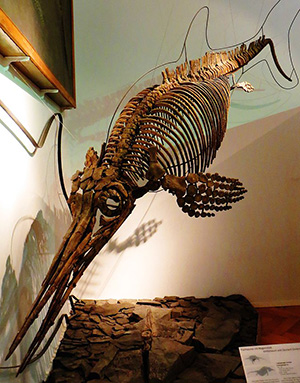
(Da: it.wikipedia.org)
Phylum: Chordata Haeckel, 1874
Subphylum: Vertebrata Cuvier, 1812
Classe: Reptilia Laurenti, 1768
Ordine: Ichthyosauria Blainville, 1835
Famiglia: Ichthyosauridae Bonaparte, 1841
Genere: Ophthalmosaurus Seeley, 1874
Specie e sottospecie
Di questo ittiosauro si conoscono varie specie, diffuse soprattutto nel Giurassico: tra le più note O. discus degli USA, a volte classificata in un genere a parte (Baptanodon). Nel Cretaceo il genere diviene molto raro e scompare dopo pochi milioni di anni. Tra le ultime specie note da ricordare O. cantabrigiensis sempre dell'Inghilterra.
Descrizione
I membri di questo genere erano caratterizzati da un corpo simile a quello dei tonni, compatto e idrodinamico; le pinne dorsali e caudali erano molto sviluppate in altezza, come si evince dalla curvatura delle vertebre caudali, mentre le zampe, trasformate in strumenti simili a pagaie, erano piuttosto corte e arrotondate, al contrario di quelle di altri ittiosauri. Le caratteristiche che rendevano unico l'oftalmosauro, però, risiedevano nel cranio: lungo e sottile come quello dei suoi parenti, era però sostanzialmente privo di denti e dotato di orbite gigantesche; in rapporto alle dimensioni, l'oftalmosauro (il cui nome significa "rettile occhio") aveva gli occhi più grandi di qualsiasi altro vertebrato. Probabilmente l'oftalmosauro dava la caccia a piccoli pesci dopo lunghi inseguimenti; le prede venivano inghiottite intere.
Diffusione
È stato un ittiosauro del medio-tardo giurassico (165-145.000.000 di anni fa), così chiamato per i suoi occhi estremamente grandi. Importanti reperti fossili di questo genere sono stati ritrovati in Europa, Nord America e Argentina.
Bibliografia
–Moon, B. C.; Kirton, A. M. (2016). "Ichthyosaurs of the British Middle and Upper Jurassic. Part 1, Ophthalmosaurus". Monographs of the Palaeontographical Society. 170 (647): 1-84.
–Motani, Ryosuke; Rothschild, Bruce M.; Wahl, William (1999). "Large eyeballs in diving ichthyosaurs" (PDF). Nature. 402 (6763): 747.
–Motani, Ryosuke (2005). "Evolution of fish-shaped reptiles (Reptilia: Ichthyopterygia) in their physical environments and constraints" (PDF). Annual Review of Earth and Planetary Sciences. 33: 395-420.
–Schwab, Ivan R (2002). "My, what big eyes you have . . ". The British Journal of Ophthalmology. 86 (2): 130.
–H.G. Seeley (1874). "On the Pectoral Arch and Fore Limbs of Ophthalmosaurus, a new Ichthyosaurian Genus from the Oxford Clay". Quarterly Journal of the Geological Society. 30 (1-4): 696-707.
–Maisch MW, Matzke AT. 2000. The Ichthyosauria. Stuttgarter Beiträge zur Naturkunde, Serie B (Geologie und Paläontologie) 298: 1-159.
–Patrick S. Druckenmiller; Erin E. Maxwell (2010). "A new Lower Cretaceous (lower Albian) ichthyosaur genus from the Clearwater Formation, Alberta, Canada". Canadian Journal of Earth Sciences. 47 (8): 1037-1053.
–Fischer, Valentin; Edwige Masure; Maxim S. Arkhangelsky; Pascal Godefroit (2011). "A new Barremian (Early Cretaceous) ichthyosaur from western Russia". Journal of Vertebrate Paleontology. 31 (5): 1010-1025.
–Valentin Fischer; Michael W. Maisch; Darren Naish; Ralf Kosma; Jeff Liston; Ulrich Joger; Fritz J. Krüger; Judith Pardo Pérez; Jessica Tainsh; Robert M. Appleby (2012). "New Ophthalmosaurid Ichthyosaurs from the European Lower Cretaceous Demonstrate Extensive Ichthyosaur Survival across the Jurassic-Cretaceous Boundary". PLOS ONE. 7 (1): e29234.
–Storrs, Glenn W.; Vladimir M. Efimov; Maxim S. Arkhangelsky (2000). "Mesozoic marine reptiles of Russia and other former Soviet republics". In Benton, M.J.; Shishkin, M.A.; Unwin, D.M. (eds.). The Age of Dinosaurs in Russia and Mongolia. Cambridge: Cambridge University Press. pp. 140-210.
–N. G. Zverkov, M. S. Arkhangelsky and I. M. Stenshin (2015) A review of Russian Upper Jurassic ichthyosaurs with an intermedium/humeral contact. Reassessing Grendelius McGowan, 1976. Proceedings of the Zoological Institute 318(4): 558-588.
–Nikolay G. Zverkov & Megan L. Jacobs (2021) [First published 2020]. "Revision of Nannopterygius (Ichthyosauria: Ophthalmosauridae): reappraisal of the 'inaccessible' holotype resolves a taxonomic tangle and reveals an obscure ophthalmosaurid lineage with a wide distribution". Zoological Journal of the Linnean Society. 191 (1): 228-275.
–McGowan C, Motani R. 2003. Ichthyopterygia. – In: Sues, H.-D. (ed.): Handbook of Paleoherpetology, Part 8, Verlag Dr. Friedrich Pfeil, 175 pp., 101 figs., 19 plts; München.
–Michael W. Maisch (2010). "Phylogeny, systematics, and origin of the Ichthyosauria - the state of the art" (PDF). Palaeodiversity. 3: 151-214.
–Fischer, V.; A. Clement; M. Guiomar; P. Godefroit (2011). "The first definite record of a Valanginian ichthyosaur and its implications on the evolution of post-Liassic Ichthyosauria". Cretaceous Research. 32 (2): 155-163.
–Barrientos-Lara, Jair Israel; Alvarado-Ortega, Jesús (2021-11-01). "A new ophthalmosaurid (Ichthyosauria) from the Upper Kimmeridgian deposits of the La Casita Formation, near Gómez Farías, Coahuila, northern Mexico". Journal of South American Earth Sciences. 111: 103499.
–Paparella, Ilaria; Maxwell, Erin E.; Cipriani, Angelo; Roncacè, Scilla; Caldwell, Michael W. (2017). "The first ophthalmosaurid ichthyosaur from the Upper Jurassic of the Umbrian-Marchean Apennines (Marche, Central Italy)". Geological Magazine. 154 (4): 837.
–Maxwell, E.E. (2010). "Generic reassignment of an ichthyosaur from the Queen Elizabeth Islands, Northwest Territories, Canada". Journal of Vertebrate Paleontology. 30 (2): 403-415.
–Fischer, V.; Maisch, M. W.; Naish, D.; Kosma, R.; Liston, J.; Joger, U.; Krüger, F. J.; Pérez, J. P.; Tainsh, J.; Appleby, R. M.; Fenton, B. (2012). "New ophthalmosaurid ichthyosaurs from the European Lower Cretaceous demonstrate extensive ichthyosaur survival across the Jurassic–Cretaceous boundary". PLOS ONE. 7 (1): e29234.
–Fernández M. 2007. Redescription and phylogenetic position of Caypullisaurus (Ichthyosauria: Ophthalmosauridae). Journal of Paleontology 81 (2): 368-375.
–Arkhangel’sky, M. S., 1998, On the Ichthyosaurian Genus Platypterygius: Palaeontological Journal, v. 32, n. 6, p. 611-615.
–Fischer, V.; Bardet, N.; Benson, R.B.J.; Arkhangelsky, M.S.; Friedman, M. (2016). "Extinction of Fish-shaped Marine Reptiles Associated with Reduced Evolutionary Rates and Global Environmental Volatility". Nature Communications. 7: 10825.
–Hudson, John D.; Martill, David M. (1991). "The Lower Oxford Clay: production and preservation of organic matter in the Callovian (Jurassic) of central England". Geological Society, London, Special Publications. 58 (1): 363-379.
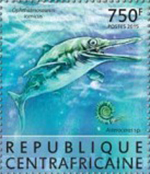
|
Data: 12/10/2015
Emissione: Animali acquatici preistorici del Giurassico Stato: Central African Republic Nota: Emesso in un foglietto di 4 v. diversi |
|---|
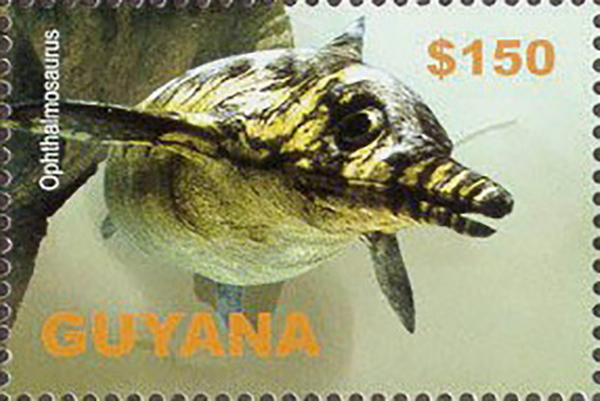
|
Data: 24/01/2005
Emissione: Animali preistorici Stato: Guyana Nota: Emesso in un foglietto di 4 v. diversi |
|---|
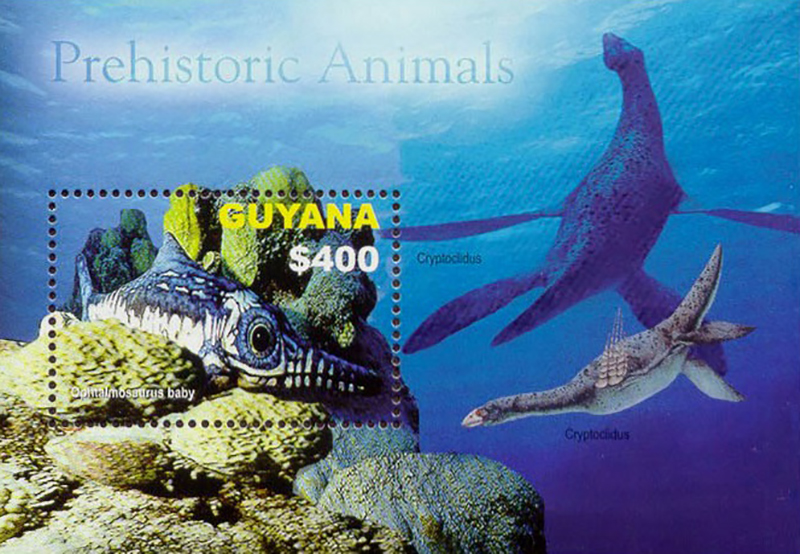
|
Data: 24/01/2005
Emissione: Animali preistorici Stato: Guyana |
|---|
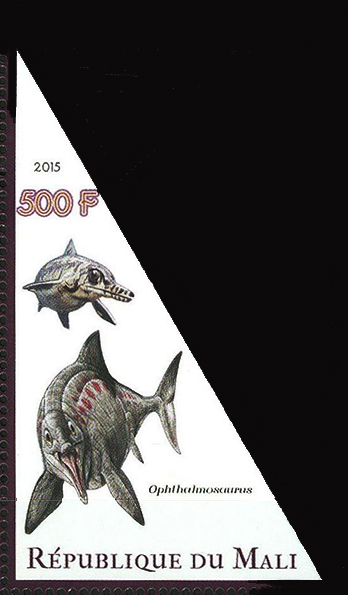
|
Data: 01/01/2015
Emissione: Dinosauri Stato: Mali |
|---|
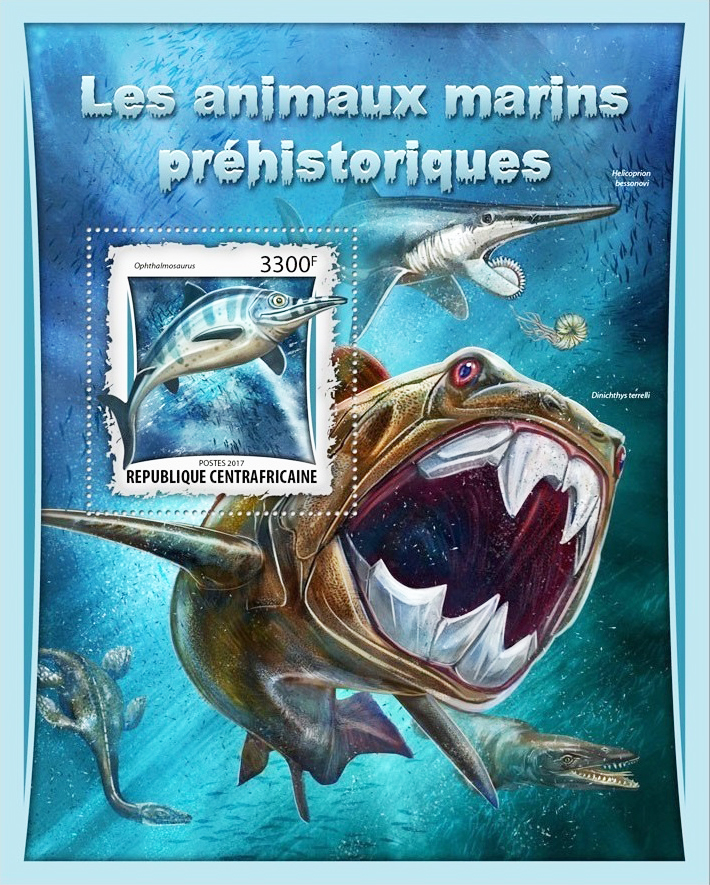
|
Data: 16/01/2017
Emissione: Animali preistorici acquatici Stato: Central African Republic |
|---|

|
Data: 15/06/2015
Emissione: Animali preistorici acquatici Stato: Togo Nota: Emesso in un foglietto di 4 v. diversi |
|---|